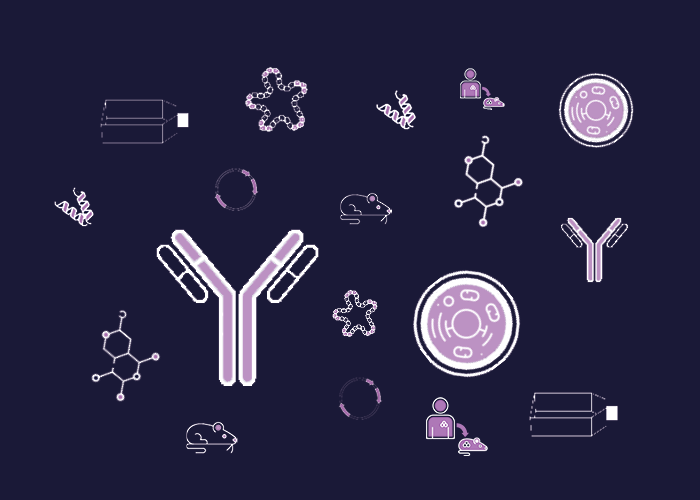Cat. #153488
Anti-BirA [6C4c7]
Cat. #: 153488
Unit size: 100 ug
Availability: 3-4 weeks
Target: BirA R118G
Class: Monoclonal
Application: IF ; WB
Reactivity: E.coli
Host: Mouse
£300.00
This fee is applicable only for non-profit organisations. If you are a for-profit organisation or a researcher working on commercially-sponsored academic research, you will need to contact our licensing team for a commercial use license.
Contributor
Institute: A*STAR Accelerate Technologies Pte Ltd
Tool Details
*FOR RESEARCH USE ONLY (for other uses, please contact the licensing team)
- Name: Anti-BirA [6C4c7]
- Alternate name: BirA antibody, bioR antibody, dhbB antibody, JW3941 antibody
- Research fields: Tags and cell markers
- Clone: 6C4c7
- Class: Monoclonal
- Conjugation: Unconjugated
- Molecular weight: 35 kDa
- Strain: C57BL/6
- Reactivity: E.coli
- Host: Mouse
- Application: IF ; WB
- Description: Monoclonal antibody to investigate the E.coli BirA protein. Background and Research Application E.coli BirA is a well-characterized multifunctional protein that either catalyses the transfer of biotin to biotin carboxyl carrier protein (BCCP), an acetyl-CoA carboxylase subunit or, alternatively, binds to the biotin operator resulting in transcriptional repression of the biotin operon. This protein also activates biotin to form biotinyl-5'-adenylate and transfers the biotin moiety to biotin-accepting proteins. A mutant BirA (R118G) shows loss of DNA binding ability and promiscuity of substrate biotinylation. These properties of BirA R118G were used to develop an in vivo proximity labelling technique that identifies potential interacting proteins (BioID). In the BioID method, a protein of interest is tagged with BirA R118G and expressed in live cells. Addition of the biotin to the culture medium results in biotinylation of proteins in vicinity of the bait. The biotinylated proteins can then be affinity purified with biotin binding proteins such as streptavidin or avidin even under harsh denaturing conditions and subsequently identified by mass spectrometry or immunoblot analysis.
- Immunogen: GST fused to E.coli BirA R118G
- Immunogen uniprot id: P06709
- Isotype: IgG1 kappa
- Myeloma used: Sp2/0-Ag14
- Recommended controls: Cells overexpressing an E.coli BirA construct
Target Details
- Target: BirA R118G
- Molecular weight: 35 kDa
- Target background: Monoclonal antibody to investigate the E.coli BirA protein. Background and Research Application E.coli BirA is a well-characterized multifunctional protein that either catalyses the transfer of biotin to biotin carboxyl carrier protein (BCCP), an acetyl-CoA carboxylase subunit or, alternatively, binds to the biotin operator resulting in transcriptional repression of the biotin operon. This protein also activates biotin to form biotinyl-5'-adenylate and transfers the biotin moiety to biotin-accepting proteins. A mutant BirA (R118G) shows loss of DNA binding ability and promiscuity of substrate biotinylation. These properties of BirA R118G were used to develop an in vivo proximity labelling technique that identifies potential interacting proteins (BioID). In the BioID method, a protein of interest is tagged with BirA R118G and expressed in live cells. Addition of the biotin to the culture medium results in biotinylation of proteins in vicinity of the bait. The biotinylated proteins can then be affinity purified with biotin binding proteins such as streptavidin or avidin even under harsh denaturing conditions and subsequently identified by mass spectrometry or immunoblot analysis.
Applications
- Application: IF ; WB
Handling
- Format: Liquid
- Concentration: 1mg/ml
- Unit size: 100 ug
- Storage buffer: PBS with 0.02% azide
- Storage conditions: -15° C to -25° C
- Shipping conditions: Dry ice
References
- Roux et al. 2012. A promiscuous biotin ligase fusion protein identifies proximal and interacting proteins in mammalian cells J Cell Biol. 196(6):801-10. PMID: 22412018.
- Choi-Rhee et al. 2004. Protein Sci. 13(11):3043-50. PMID: 15459338.
- Goodchild et al. 2004. Mislocalization to the nuclear envelope: an effect of the dystonia-causing torsinA mutation. Proc Natl Acad Sci U S A. 101(3):847-52. PMID: 14711988.
- Streaker et al. 2003. Coupling of protein assembly and DNA binding: biotin repressor dimerization precedes biotin operator binding. J Mol Biol. 325(5):937-48. PMID: 12527300.
- Kwon et al. 2000. Multiple disordered loops function in corepressor-induced dimerization of the biotin repressor. J Mol Biol. 304(5):821-33. PMID: 11124029.




